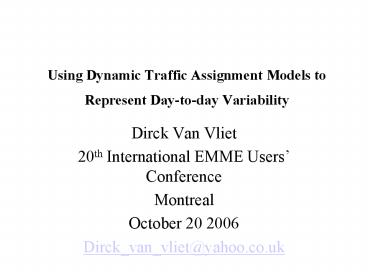Using Dynamic Traffic Assignment Models to Represent Day-to-day Variability PowerPoint PPT Presentation
1 / 16
Title: Using Dynamic Traffic Assignment Models to Represent Day-to-day Variability
1
Using Dynamic Traffic Assignment Models to
Represent Day-to-day Variability
- Dirck Van Vliet
- 20th International EMME Users Conference
- Montreal
- October 20 2006
- Dirck_van_vliet_at_yahoo.co.uk
2
Order of Events
- Brief CV / Plea for briefcase!
- Designing network programmes for 2006, not 1976
- Role of equilibrium solutions
- Impact and modelling of day-to-day variability
- Conclusions
3
Who am I? A brief CV
- Born in Montreal
- Van Vliet Bros.
- Maths and Physics at McGill
- Physics PhD etc. 1963 to 1970 UK
- Greater London Council 1971 1974
- Institute for Transport Studies, University of
Leeds 1974 2001/2006 - SATURN Assignment Suite 1976 to date
4
A new Generation of Dynamic Traffic Models Two
Issues
- Equilibrium or not?
- Variability or not?
5
Previous Related Papers
- What happens when it rains? MSc dissertation
1980s - Effect of variability in travel demand and
supply on urban network evaluation Willy Mutale,
PhD Leeds (1992) - DRACULA Project, ITS 1992-95 (Dave Watling and
Ronghui Liu)
6
Equilibrium Model Assumptions
- Tij (or Ttij) fixed and independent of the day
- Costs uniquely determined by flows and do not
vary between days - All drivers have same rational objectives
- Perfect information
- Same optimum driver decisions every day
- No influence of previous network
- No en-route diversions
7
Equilibrium (Static) Network Assumptions
- Link travel costs are separable
- Loading is simultaneous
- Queuing between time slices ignored
- Time-sliced costs are instantaneous
- Link data (capacities etc.) are taken during
neutral months (October?)
8
2 Basic Equilibrium Problems
- 1. Over-estimate driver abilities to choose
optimum routes - 2. Under-estimate the complexity of traffic
conditions - Therefore they give an over-optimistic
estimate of network conditions
9
Conclusions for Dynamic Assignment Models in 2006
- Deterministic single point solution equilibrium
is less than perfect starting point - Need to model a distribution of possible states,
not a single predicted average state
10
Day-to-day Variability
- Traffic conditions vary from day to day a lot!
Why? - Differences in O-D demand patterns
- Differences in departure time and/or route choice
- Day of the week
- Holidays
- Seasonal effects (e.g., daylight)
- Weather
- Road works / Incidents
- Information systems
11
Willy Mutales PhD
- Run a network assignment using SATURN to
equilibrium using average/neutral inputs - Simulate repeated daily trials with random
selections of - (1) The O-D trip matrix
- (2) Route choice proportions
- (3) Link saturation flows etc. both globally
(e.g. weather) and locally (incidents) - Record the distribution of pcu-hrs etc. etc.
12
Willy Mutales Results
- Highly skewed distributions of, e.g., total
pcu-hrs - True average therefore greater than the mode or
median - A real-life study of North Leeds showed an
increase of 14 in total travel time.
13
DRACULA
- Based on a micro-simulation approach to both
demand and supply - The system evolves day to day
- Daily individual driver demands based on
previously experienced O-D costs - Individual daily route and departure time choice
based on previous network experience - Daily network conditions subject to random
fluctuations - Incremental time simulation of all trips
14
DRACULA Conclusions
- Day-to-day simulations are feasible on not too
big networks - Converges to give stable distributions
- Results broadly similar to Mutales
- Provides a handle on reliability
- But calibration is a major issue (e.g., car
following, lane changing, give ways, etc. etc.) - An idea ahead of its time?
15
How to Model Day-to-day Variability using
Simpler Dynamic Models
- Run the system to normal convergence
- Initiate a series of day-to-day runs with
- (i) Tij choosen from Nor(Tij , aTij )
- (ii) Route p from multinomial distribution Ppij
- (iii) Global individual multipliers for link
speeds and capacities - (iv) Random incidents
16
Conclusions
- Variability is highly significant
- It may lead to biases in comparing schemes based
on different modes - Modelling using existing dynamic micro-simulation
models (e.g., DYNAMEQ) should not be difficult. - Give it a go!

